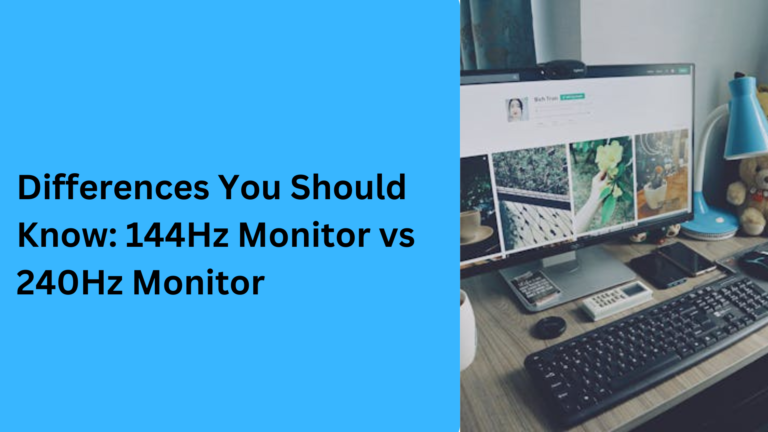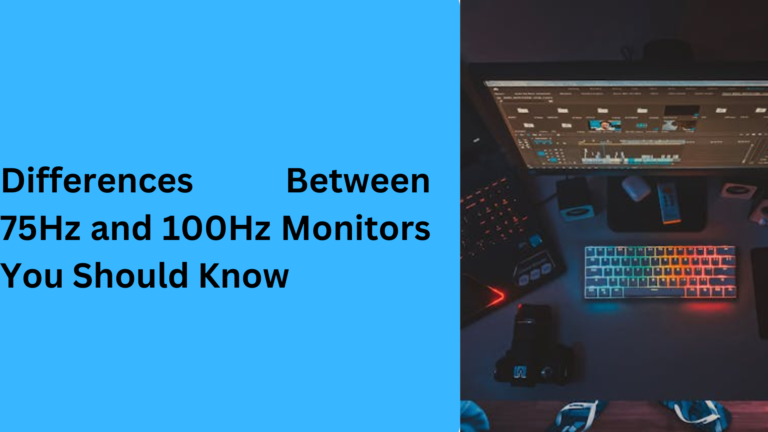10 Key Differences Between a 22-Inch Monitor vs. a 24-Inch Monitor for Gaming and Work
When shopping for a new monitor, especially for gaming or work, the choice between a 22-inch and a 24-inch monitor can be tricky. Both have their unique advantages and drawbacks, and making the right decision depends on what you need from your display. In this guide, we’ll discuss the key differences between a 22-inch monitor and a 24-inch monitor for gaming and work. These factors will help you make an informed decision based on your needs and preferences.
1. Display Size and Screen Real Estate: 22-Inch vs. 24-Inch Monitor for Gaming and Productivity
The most obvious difference when comparing a 22-inch monitor to a 24-inch monitor is the screen size. A 22-inch display offers a smaller viewing area, which might be ideal for compact desk spaces or those who don’t require a lot of screen real estate. However, if you’re working on tasks like graphic design, video editing, or multitasking, a 24-inch monitor will provide more space for multiple windows and applications. This larger screen size enhances productivity, especially for those using multiple windows side by side. For gaming enthusiasts, the extra size of a 24-inch display can provide more immersive experiences without feeling overwhelming.
2. Resolution and Image Clarity: How a 22-Inch Monitor Stacks Up Against a 24-Inch Monitor
Resolution plays a huge role in image quality and clarity, particularly when comparing 22-inch monitors vs. 24-inch monitors. Both monitors may feature 1080p Full HD resolution, but the larger screen size of the 24-inch monitor means the pixel density is slightly lower compared to the 22-inch display. This difference is often negligible at typical viewing distances, but if you’re working on detailed photo editing or video production, the sharper pixel density of a 22-inch display can make a difference for fine details. On the other hand, a 24-inch monitor with a higher resolution, such as 1440p or 4K, offers a more detailed and crisp image, which benefits high-end gaming and professional work environments where sharp visuals are crucial.
3. Performance for Gaming: How 22-Inch vs. 24-Inch Monitors Impact Your Experience
When considering gaming monitors, performance is key. A 24-inch monitor is often preferred by serious gamers due to its larger screen size and better compatibility with high-performance settings, like 144Hz refresh rate and 1ms response time. These features contribute to a smooth gaming experience, especially in fast-paced games where every millisecond counts. On the other hand, a 22-inch monitor for gaming may be enough for casual players, providing an adequate size for gaming at 1080p resolution. If you play games like MOBA, RPG, or indie games, a 22-inch screen might suffice without compromising on performance. But for competitive gamers who require a high refresh rate and immersive visuals, the 24-inch gaming monitor is the better option.
4. Viewing Comfort: Choosing Between a 22-Inch vs. 24-Inch Monitor for Eye Comfort
Screen size affects your viewing comfort, especially during long working hours or gaming sessions. While a 22-inch monitor is easier to fit into smaller spaces and might provide a more compact, comfortable viewing experience for some, the 24-inch monitor can feel more spacious and reduce the need for excessive scrolling or adjusting windows on the screen. The larger screen size of a 24-inch monitor allows you to sit slightly farther away, reducing strain on your eyes. However, for those with limited desk space or for those who prefer sitting close to the screen, the 22-inch monitor might be more comfortable, especially when it comes to maintaining good posture and preventing eye fatigue.
5. Price and Budget: Is a 24-Inch Monitor Worth the Extra Cost?
Price is an important factor when choosing between a 22-inch vs. 24-inch monitor, especially for those on a budget. 22-inch monitors generally come at a more affordable price, making them a popular choice for people who want a budget-friendly monitor for work or casual gaming setups. If you’re not picky about having a larger display, the 22-inch monitor will likely provide great value. On the other hand, 24-inch monitors often come at a higher price, but for those who want better screen size, enhanced features like higher resolution or refresh rates, and improved gaming or work performance, the extra cost is usually justified. However, be mindful of what you truly need—if you don’t require a lot of space or enhanced features, the 22-inch monitor offers a great balance between price and performance.
6. Desk Space and Ergonomics: How a 22-Inch vs. 24-Inch Monitor Affects Your Workspace Setup
When setting up a workspace for gaming or work, desk space and ergonomics are crucial considerations. A 22-inch monitor is often ideal for those with smaller desks or limited space. Its compact size allows for easier setup, and it doesn’t take up much room, leaving space for keyboard, mouse, and other accessories. If your office space is tight or if you’re working in a shared environment, the smaller 22-inch monitor is the perfect choice. However, a 24-inch monitor provides more screen real estate, which can be advantageous for a more comfortable working position. Although it requires more desk space, the larger screen size helps to reduce neck strain by giving you more room to adjust the display’s height, angle, and distance.
7. Gaming Immersion: Does a 22-Inch Monitor Compare to a 24-Inch Monitor for Gaming Experiences?
For those who value gaming immersion, the difference between a 22-inch monitor and a 24-inch monitor is noticeable. The larger 24-inch monitor allows for a wider field of view, providing a more immersive gaming experience. Whether you’re playing first-person shooters (FPS) or open-world adventure games, the larger display brings you closer to the action. The added screen size can create more detailed visuals and enhanced gameplay realism, making it a top choice for avid gamers. Conversely, a 22-inch gaming monitor may not provide the same level of immersion but still offers solid performance for casual gaming. If you’re tight on budget or desk space, a 22-inch monitor can still deliver a quality gaming experience, but for competitive or professional gaming, the 24-inch monitor offers greater satisfaction.
8. Viewing Angles: Comparing the Viewing Angle Quality of 22-Inch vs. 24-Inch Monitors
The viewing angles of a monitor can affect how well you can see the screen when not sitting directly in front of it. For work tasks like presentations or team collaborations, a wider viewing angle can be important. 24-inch monitors tend to have better viewing angles, making them suitable for situations where multiple people are looking at the screen at once. A 22-inch monitor usually provides good viewing angles too, but the smaller screen might not be as effective in a shared or group environment. The extra size of a 24-inch display means it’s easier to see from a wider range of positions, especially when viewing media content or working on projects that require sharing ideas with colleagues.
9. Response Time and Refresh Rate: How They Differ Between 22-Inch and 24-Inch Monitors for Gaming Performance
When it comes to gaming performance, response time and refresh rate are crucial factors that can affect how smoothly the game runs. Many 24-inch gaming monitors offer higher refresh rates, such as 144Hz or 240Hz, and faster response times, like 1ms, providing a competitive edge in fast-paced games. These features allow for smoother and more responsive gameplay, which is especially important in competitive eSports. However, 22-inch monitors can also offer excellent gaming performance with decent response time and refresh rates suitable for casual or entry-level gaming. If you’re looking for gaming at 1080p with standard settings, a 22-inch monitor might offer enough performance, but if you’re aiming for ultra-fast refresh rates and smoother performance, a 24-inch monitor will be the better choice for serious gamers.
10. Long-Term Investment: Is a 22-Inch or 24-Inch Monitor More Future-Proof for Gaming and Work?
When considering the long-term value of your purchase, a 24-inch monitor is generally more future-proof than a 22-inch monitor. With advancements in gaming technology, higher resolutions, and multitasking needs, larger monitors provide better flexibility to adapt to new software, hardware, and emerging trends in gaming and work environments. A 24-inch monitor is more likely to support upgrades in resolution and performance as gaming and work requirements increase. On the other hand, while a 22-inch monitor remains a solid choice for the short term, it might feel cramped in a few years as screen real estate demands grow. Whether you’re gaming, editing photos, or working on complex spreadsheets, a 24-inch monitor offers a better investment, ensuring you’re equipped to handle future advancements in technology.
1. What are the main differences between a 22-inch monitor and a 24-inch monitor for gaming?
The main differences between a 22-inch monitor vs 24-inch monitor for gaming include the screen size, which directly affects game immersion. A 24-inch monitor for gaming offers a larger field of view, making games feel more immersive. It also typically supports higher refresh rates and faster response times, enhancing gaming performance, especially in fast-paced games. A 22-inch gaming monitor may still deliver solid performance for casual gamers, but it doesn’t provide the same level of visual experience and screen real estate as a 24-inch display.
2. Is a 22-inch monitor enough for work and productivity tasks?
Yes, a 22-inch monitor is sufficient for work and productivity tasks, especially for tasks like emailing, document editing, and browsing the web. It offers an ideal size for smaller desks or tight workspaces. However, if you need to work with multiple applications side-by-side or engage in tasks such as photo editing or video production, a 24-inch monitor for productivity might offer more screen space and improve your efficiency with more visual real estate.
3. Which is better for multitasking: a 22-inch monitor or a 24-inch monitor?
For multitasking, a 24-inch monitor is generally the better option. Its larger screen size allows for easier viewing of multiple windows at once, making it ideal for tasks like working with spreadsheets, graphic design, and coding. A 22-inch monitor can handle basic multitasking needs, but you may find the limited screen space a bit cramped when managing multiple windows simultaneously. Therefore, for a more efficient work setup, the larger 24-inch monitor provides a significant advantage.
4. Is a 22-inch or 24-inch monitor better for video editing and creative work?
For video editing and other creative tasks, a 24-inch monitor is usually the better choice. The additional screen space allows you to have more workspace for timelines, toolbars, and previews, enhancing productivity and reducing the need for scrolling. A 22-inch monitor for video editing can still work, but it may feel restrictive when working on detailed projects that require precise visual elements. A 24-inch monitor for creative professionals offers better color accuracy and more room for editing software, making it a better long-term investment for professionals in the creative industry.
5. How does the price of a 22-inch monitor compare to a 24-inch monitor?
The price difference between a 22-inch vs 24-inch monitor is generally modest, but a 24-inch monitor tends to be more expensive. However, the extra cost is often justified by the larger screen size, which offers more visual real estate for work or gaming. If you are on a budget, a 22-inch monitor may still provide good value for standard use, such as office work or casual gaming. For those who require better gaming performance, higher refresh rates, or more workspace for productivity, investing in a 24-inch monitor might be the better option for long-term use.


